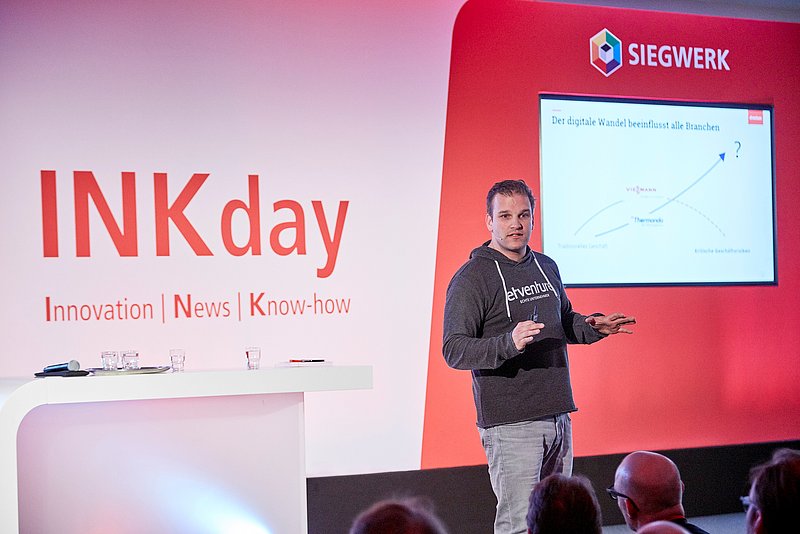
Colors are passion, emotions and personality. At Siegwerk, inks and coatings are our specialty and we use color to bring the packaging and products of our customers to life.

Q: Why do analog companies have to follow the digital change in the first place?
A: Digital change affects all industries - no matter if B2C or B2B. Depending on the industry’s stage of change the struggle for existence is getting harder, the market is flooded by new business models and completely new competitors. Companies need to change in order to further survive. They need to create future value for their business. As anywhere else in life, it’s easy to talk about digital transformation but it’s hard to actually do it. And that’s exactly where we support our clients.
Q: What is the challenge for companies?
A: The most significant challenge is that tomorrow’s competition won’t only include today’s competitors. Companies need to further develop their existing business models and establish their own future strategies in today’s world. At the same time, today’s businesses already need to shape the future of work. Companies need to think radically different and create an innovative positioning at the market. It’s about the development of digital business models and digital customer channels. Existing businesses need to get digitized offering an optimized customer experience and new digital business opportunities need to be discovered and successfully implemented.
Q: What does digital transformation look like?
A: Generally speaking, there are three types of digital transformation. We speak of incremental changes if digital initiatives refer to necessary adjustments within the core business itself, for example through digital tools to achieve optimization and to increase efficiency. Besides this, it’s getting a bit harder as you partially target new customers and also offer new services. Here we talk about things like predictive maintenance. The third type follows a disruptive approach by only looking at completely new customers targeted by a completely new business model like for example “pay per use”. Subsequently, you need to build new assets in your company to serve the new customer group and run the new business. Most companies only think of optimization when they talk about digitization, this is not enough.
Q: Can you give an example for digital change in a previous analog market environment?
A: Farmers for example don’t work anymore as analog as you might think. Quite the contrary, they are already working more digital than others. Today, smart farms are already gathering all kind of data sent by sensors attached to livestock, by tractors and mowers and maybe also by aerial drones that map the fields. Everything is collected by a single platform offering the farmer a digital data system allowing to make decisions on field cultivation, animal care or general purchasing. Consequently, this changed the environment for all companies making business in the farming sector. Tractor or machinery manufacturers had to adjust their offerings by adding innovative smart features and services to their products in order to enable data collection while connecting to platforms mainly used by customers. So, what happened here? Digital platforms have entered the traditional agricultural market and without connectivity to these platforms other suppliers drive themselves out of today’s market.
Q: How can traditional companies start into their digital transformation?
A: To answer this, you should look at the difference of traditional companies and agile startups. Traditional companies have assets, know-how, look on long-standing customer and supplier relationships, and have employees who are absolute specialists in their areas. Whereas startups always begin from total scratch. But in return these market newcomers take risks, have a high test mentality, think user- and data-centric and act fast. Sales and profit is not as important as the collection of data. So, this means for traditional companies that they need to build new strengths to get through digital change. They should not only look at strengths of startups they need to embrace them. They need to get away from an engineering to a user-centric approach when thinking about digital transformation, new business models and digital channels. Startup methods like design thinking lean startup can help to master the change. The most important thing is, that it’s a top management topic - the CEO needs to understand and drive the change.
But it only works if change has a protected room independent from corporate rules and systems. Companies need to build an autarkic digital unit with people only looking into digitization – shielded against the core organization. In this protected environment the team then identifies potential areas, creates and tests ideas, and collects and validates data. Ideas that were proven to work are then integrated into the core organization so that products or services can be validated in real business environment and finally being implemented.
Q: Is there a process companies should follow?
A: After many years of accompanying clients – mid-sized and group companies – through their digital transformation we have a proven process that works for everyone - no matter if you want to establish a startup, develop new business models or run a transformation. The process always consists of the same four phases and is continuously accompanied by user tests for validation and optimization:
• Phase 1: Identify your customer, supplier and partner pain points
• Phase 2: Quickly test concepts – and identify the optimum approach
• Phase 3: Develop minimum viable products and conduct live tests
• Phase 4: Roll out to market quickly – with KPI-based optimization
The first three phases take place in the protected environment, where the digital unit develops ideas and concepts free from corporate influences. Everything that is done in every single phase is focused on the user. To create something successful and sustainable, you should not think in a product world with the aim to build perfect products. It only works if you think user-centric from the early beginning in phase 1.
Q: What is your key message for companies that haven’t started yet?
A: To put it in a nutshell: Start today, be open, be fast, observe the market, talk to stakeholders, identify their pain points, create ideas, run tests, validate and implement – most importantly, just do it.
For more information about etventure and their services please visit https://www.etventure.com/